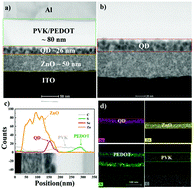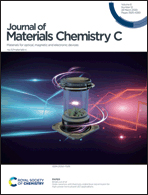All-solution processed high performance inverted quantum dot light emitting diodes†
Abstract
All-solution processed colloidal quantum dot light emitting diodes (QLEDs) with record performance have been successfully realized by introducing a dually-doped poly(ethylenedioxythiophene)/polystyrenesulfonate (PEDOT:PSS) hole-injection layer and a polyethylenimine (PEI) interfacial layer. Doping PEDOT:PSS with both Zonyl and isopropanol (IPA) significantly improves the wettability of PEDOT:PSS, enabling the coating of hydrophilic PEDOT:PSS onto the hydrophobic hole-transporting layer poly(9-vinlycarbazole) (PVK) possible. The PEI interlayer between PVK/QD layers not only lowers the vacuum level, thereby reducing the hole-injection barrier to balance the charge carriers, but also passivates QD surface defects via its amine group to suppress fluorescence quenching. As a result, a peak current efficiency of 28.1 cd A−1, 43.1 cd A−1, and 1.26 cd A−1, a maximum external quantum efficiency (EQE) of 20.6%, 10.4%, and 2.95%, and a maximum luminance of 5.06 × 104 cd m−2, 1.21 × 105 cd m−2, and 2.96 × 103 cd m−2 have been achieved for red, green, and blue QLEDs, respectively. To the best of our knowledge, the red device's EQE is one of the highest among all inverted red QLEDs. In addition, the extrapolated lifetime of the red QLEDs sets a new record by reaching 8253 h at an initial brightness of 100 cd m−2.



 Please wait while we load your content...
Please wait while we load your content...